1. Meaning of Accounting
CHAPTER 1
INTRODUCTION TO ACCOUNTING
MEANING OF ACCOUNTING
AMERICAN INSTITUTE OF CERTIFIED PUBLIC
ACCOUNTANTS
“Accounting is the art of recording, classifying and summarizing in a significant manner and in terms of money, transactions and events, which are in part at least, of a financial character, and interpreting the results thereof.”
Accounting is the process of recording financial transactions pertaining to a business. The accounting process includes summarizing, analyzing, and reporting these transactions to oversight agencies, regulators, and tax collection entities. The financial statements used in accounting are a concise summary of financial transactions over an accounting period, summarizing a company's operations, financial position, and cash flows.
NEED FOR ACCOUNTING
• In all activities and organizations (business or non-business) which require money and
other economic resources, accounting is required to account for these resources.
• In other words, wherever money is involved, accounting is required to account for it.
• Accounting is often called the language of business. The basic function of any language is
to serve as a means of communication. Accounting also serves this function.
Qualitative Characteristics of Accounting Information
Reliability
Reliability means the users must be able to depend on the information. The reliability of accounting information is determined by the degree of correspondence between what the information conveys about the transactions or events that have occurred, measured and displayed. A reliable information should be free from error and bias and faithfully represents what it is meant to represent.
Relevance
To be relevant, information must be available in time, must help in prediction and feedback, and must influence the decisions of users by : (a) helping them form prediction about the outcomes of past, present or future events; and/or (b) confirming or correcting their past evaluations.
Understandability
Understandability means decision-makers must interpret accounting information in the same sense as it is prepared and conveyed to them. The qualities that distinguish between good and bad communication in a message are fundamental to the understandability of the message. A message is said to be effectively communicated when it is interpreted by the receiver of the message in the same sense in which the sender has sent. Accountants should present the comparable information in the most intenlligible manner without sacrificing relevance and reliability.
Comparability
It is not sufficient that the financial information is relevant and reliable at a particular time, in a particular circumstance or for a particular reporting entity. But it is equally important that the users of the general-purpose financial reports are able to compare various aspects of an entity over different time period and with other entities. To be comparable, accounting reports must belong to a common period and use common unit of measurement and format of reporting.
1. Meaning of Accounting
- Books Name
- CA Shivali kedia Accountancy Book
- Publication
- CA Shivali kedia
- Course
- CBSE Class 11
- Subject
- Accountancy
Meaning of Accounting:
“Accounting may be defined as the process of recording, classifying, summarizing, analyzing and interpreting the financial transactions and communicating the results to the persons interested in this information”
Only Events related to Business which can be expressed in terms of Money are Economic Transactions and Economic Events.
1. Meaning of Accounting
- Books Name
- Vision classes Accountancy Book
- Publication
- Vision classes
- Course
- CBSE Class 11
- Subject
- Accountancy
Chapter 1:
Introduction to Accounting
MEANING OF ACCOUNTING
“Accounting is the art of recording, classifying and summarizing in a significant manner and in terms of money, transactions and events, which are in part at least, of a financial character, and interpreting the results thereof.”
Accounting is the process of recording financial transactions pertaining to a business. The accounting process includes summarizing, analyzing, and reporting these transactions to oversight agencies, regulators, and tax collection entities. The financial statements used in accounting are a concise summary of financial transactions over an accounting period, summarizing a company's operations, financial position, and cash flows.
NEED FOR ACCOUNTING
• In all activities and organizations (business or non-business) which require money and other economic resources, accounting is required to account for these resources.
• In other words, wherever money is involved, accounting is required to account for it.
• Accounting is often called the language of business. The basic function of any language is to serve as a means of communication. Accounting also serves this function.
1. Generally Accepted Accounting Principles
- Books Name
- Vision classes Accountancy Book
- Publication
- Vision classes
- Course
- CBSE Class 11
- Subject
- Accountancy
CHAPTER -2
THE THEORY BASE OF ACCOUNTING
Generally Accepted Accounting Principles (GAAP)
In order to maintain uniformity and consistency in accounting records, certain rules or principles have been developed which are generally accepted by the accounting profession. These rules are called by different names such as principles, concepts, conventions, postulates, assumptions and modifying principles. The term ‘principle’ has been defined by AICPA as ‘A general law or rule adopted or professed as a guide to action, a settled ground or basis of conduct or practice’.
The word ‘generally’ means ‘in a general manner’, i.e. pertaining to many persons or cases or occasions. Thus, Generally Accepted Accounting Principles (GAAP) refers to the rules or guidelines adopted for recording and reporting of business transactions, in order to bring uniformity in the preparation and the presentation of financial statements. For example, one of the important rule is to record all transactions on the basis of historical cost, which is verifiable from the documents such as cash receipt for the money paid. This brings in objectivity in the process of recording and makes the accounting statements more acceptable to various users. The Generally Accepted Accounting Principles have evolved over a long period of time on the basis of past experiences, usages or customs, statements by individuals and professional bodies and regulations by government agencies and have general acceptability among most accounting professionals.
However, the principles of accounting are not static in nature. These are constantly influenced by changes in the legal, social and economic environment as well as the needs of the users. These principles are also referred as concepts and conventions. The term concept refers to the necessary assumptions and ideas which are fundamental to accounting practice, and the term convention connotes customs or traditions as a guide to the preparation of accounting statements. In practice, the same rules or guidelines have been described by one author as a concept, by another as a postulate and still by another as convention. This at times becomes confusing to the learners. Instead of going into the semantics of these terms, it is important to concentrate on the practicability of their usage. From the practicability view point, it is observed that the various terms such as principles, postulates, conventions, modifying principles, assumptions, etc. have been used inter- changeably and are referred to as Basic Accounting Concepts in the present chapter.
1. Generally Accepted Accounting Principles
- Books Name
- CA Shivali kedia Accountancy Book
- Publication
- CA Shivali kedia
- Course
- CBSE Class 11
- Subject
- Accountancy
Generally Accepted Accounting Principles
- GAAP is a collection of commonly followed accounting rules and standards in the preparation of financial statements.
- GAAPs are generic in nature and every country has its own GAAP, Example UK GAAP, US GAAP.
- In India, we have Indian Accounting Standards which are more specific to Indian Accountants.
- These principles are referred to as concepts or principles.
- Accountants are prepared on the basis of the principles laid down by IFRS.
- IFRS helps in Financial statements comparison, uniformity and analysis.
- The standards are prepared by the Financial Accounting Standards Board (FASB)
- These principles are constantly changing due to changes in the external environment (legal, social and economic environment)
- Cost basis principle requires that assets will be shown in the financial statements “on cost” i.e. on the purchase price. This has to be supported with the bill or voucher for correctness and trueness.
2. Basic Accounting Concepts
- Books Name
- Vision classes Accountancy Book
- Publication
- Vision classes
- Course
- CBSE Class 11
- Subject
- Accountancy
Basic Accounting Concepts
Accounting Principles
Principles of Accounting are the general law or rule adopted or proposed as a guide to action, a settled ground or basis of conduct or practice. Accounting principles are man-made. Unlike the principles of physics, chemistry, and the other natural sciences, accounting principles were not deducted from basic axioms, nor is their validity verifiable by observation and experiment. Instead, they have evolved. This evolutionary process is going on constantly; accounting principles are not “eternal truths”.
Business Entity Concept
This concept considers a business unit as a separate entity. Business and businessman are two separate entities and all the business transactions are recorded in the books of accounts from business point of view.
Dual Aspect Concept
This Concept also known as equivalence concept signifies that every business transaction has two fold effects or every transaction affects at least two accounts. This concept is, in fact, the base on which Double Entry System of Book-Keeping is based. According to this principle, every debit has a corresponding credit.
Accounting Period Concept
According to this concept the long life of business is divided into justifiable accounting periods so as to help businessman to know the results of his investment during each such period. This period is known as accounting period and the length of this period depends on the nature of business. Accounting period may be either a calendar year (From January 1 to December 31) or the fiscal year of the Govt. (April 1 to March 31)
Going Concern Concept
This concept assumes that every business has a long and indefinite life. Since financial statements are prepared on the basis of this concept, all fixed assets are shown in the books at their cost ignoring their market value.
Cost Concept
According to this concept all fixed assets are recorded in the books at cost i.e. the price paid to acquire them. Any subsequent increase or decrease in their value will not be shown in the records except the depreciation of these assets. In subsequent years, therefore fixed assets are shown at cost less depreciation provided on them up to date. Continuous charging of depreciation on the asset will ultimately eliminate the asset from the books.
Money Measurement Concept
According to this concept only those transactions are recorded in the books of accounts which can be expressed in monetary terms. The non-financial or non-monetary transactions do not find any place in the accounting records. Money is the common denominator to denote the value of the various assets of diverse nature to give a meaningful total of these assets.
Matching Concept
This concept states that it is necessary to charge all the expenses incurred to earn revenue during the accounting period against that revenue in order to ascertain the net income or trading results of the business. The matching concept which is so closely related to accrual concept and accounting period concept helps a businessman in realizing his objective i.e. in ascertaining the trading results or profit or loss from the business. For ascertaining the net income.
Accounting Equivalence Concept
According to this concept assets owned by the business must be equal to the funds contributed by the businessman in the form of capital. These days when business is to be carried on a large scale, funds may be borrowed from third parties to supplement the funds contributed by the proprietor.
Realization Concept
According to this concept income is treated as being earned on the date on which it is realized i.e. the date on which goods or services are transferred to the customers. Since this exchange of goods or services may be for cash or on credit, it is not important whether cash has actually been received or not.
Objective Evidence Concept or Verifiable Objective Concept
This concept justifies the significance of verifiable documents supporting various transactions. According to it, each transaction should be supported by objective evidences like vouchers. Objective evidence, here, means evidence free from bias of the accountant.
Materiality
This principle emphasizes that only those transactions should be recorded which are material or relevant for the determination of income from the business. All immaterial facts should be ignored.
Full Disclosure
This concept implies that financial statements should disclose all material information which is required by the proprietor and other users to assess the final accounts of the business unit
Consistency
This principle requires that accounting practices, methods and techniques used by a business unit should be consistent. A business unit can adopt any accounting practice, but once a particular practice is chosen, it must be used for a number or years.
Conservatism or Prudence
This principle is nothing but a formal expression of the maxim “Anticipate no profits and provide for all possible losses.” In other words, it considers all possible losses but ignores all possible profits.
Timeliness of Information
Accounting information to the management should be supplied in time and frequently so that some rational decisions may be taken. If information is not supplied in time, it will obstruct the quick decision-making process of the undertaking.
2. Basic Accounting Concepts
- Books Name
- CA Shivali kedia Accountancy Book
- Publication
- CA Shivali kedia
- Course
- CBSE Class 11
- Subject
- Accountancy
Accounting assumptions
It is mandatory for every relisted company to get its accounts audited by an independent chartered accountant.
This has to be done for the use of financial statements. Whenever a company’s accounts are closed on 31st March, the CA goes and checks the correctness of the profit and loss account balance sheet and if you are reported to shareholders that everything is true and fair.
Accounting assumptions are three points which are assumed by the CA that comma these three assumptions are followed by the company while making the final accounts that is profit and loss and balance sheet.
Going concern assumption
Under this assumption, it is assumed that the business is going to continue for the next possible future that is there is no hurdle and the company’s operations are running smoothly.
Now, why is something so obvious an important accounting assumption let's understand the help of a scenario.
Imagine a scenario where there is a fire in the companies goes down biggest godown and all the production has stopped temporarily.
If the owner lets out this information that the production has stopped immediately the market value will go down the creditors will get upset the banks who have given loans will get alerted it will create more problems for the company because a company always wants to survive.
To protect the uses of financial statements is important for the CA to give his report on whether the fundamental accounting assumption of going concerned has been affected or not
What will happen if the going concern of a company is affected
The difference between capital expenditure and revenue expenditure is over. If there is no distinction between revenue expenditure and capital expenditure. All the major expenditures are considered as expenses and they're expensed out in the profit and loss accounts.
Accrual
In old times how did businessmen calculate their profit and losses? It was very simple to add all the cash which has been received in a given year and subtract all the payments made this year if there is any cash left in its profits.
Companies act 2013 does not follow this manner of accounting. Companies act says that it doesn't matter whether cash has been received or not in a given year. What matters is whether it was this current year's income.
Let us say that rent per month is rs 1000 yearly rent becomes 1000 into 12000 rupees. You have been the rent for April to December that is 1000 into 9 9000 rupees but you could not pay for January 2 March 3 months 3 into 3000.
As per accrual, it doesn't matter how much cash you have paid you have to account for the entire 12 months expense.
Similarly, it does not matter if you have received the income in cash or not what matters is it the income of the current year
Income of the current year minus expense of the current year can only give us the profit for the whole year.
In the case of cash basis of accounting, it is difficult and almost impossible to get the profit for the whole 12 months if you are not considering income and expenses for the 12th months.
There are four accounts that we will study in the approval system in the coming chapters namely outstanding expense prepaid expense accrued income and unearned income
Consistency
If you are planning to become a finance professional, you will realize that a companies act and income tax act gives us a few flexibility or options while preparing accounts.
For example
There are two methods of calculating depreciation which was going to study this year. Straight-line method and written down value method. The company can choose what method suits it best. Another example which you are going to study next year. While preparing the capital account apartments can follow 2 methods fixed capital account and fluctuating capital account.
The consistency principle says whenever a company chooses anyone such a method for the next years and the coming future years the company has to be consistent with it and continue using the same method.
So if the company follows the straight-line method in this year and next year changes it to the return down value method it will be in contradiction to the principle of consistency.
Business entity principle
Let me start with an example
Ram and Shyam are two friends who want to open a firm called RS and associates.
Ram and Shyam are two different beings who have their respective birth certificates driving licenses and Aadhar cards. When both of them registered a firm called RS and associates a new artificial baby is born in the eyes of the law. Rs associate is a new person different from its owners Ram and Shyam. Run associates will have a separate bank account separate address proof and a separate identity.
The business entity principle explains that a business is a different entity from its owners.
Accounting period concept
As per the income tax act, 1962 and the companies act 2013 all the businesses in India prepare their books of accounts annually starting from the first of April and ending to ending 31st March.
Under the accounting period concept, it becomes important to calculate the profits for a given period in which can be monthly quarterly or annually. Around the World books of accounts are prepared for 12 months that is annually
Cost concept
The cost concept mandates that the acid will appear in the balance sheet on its cost price full stop for example.
A business purchased a building for 3 lakh rupees and after 10 years the market value has raised reason to 50 lakh. According to the cost, concept acids are recorded in the balance sheet on cost price that is bracket open purchase price closed not the market value.
What is the cost?
Cost is considered the purchase price plus all the expenses in curd to bring the acid into using condition.
For example, we purchase AC for 25000 and to start and make it in a working condition we spend 2000 or the carpenter and 1000 on the transportation charges. As per the cost concept, the cost of the AC is 25000 + 2000 + 10000 which is 28000. In our books, the AC will be recorded on the planting machinery head for 28000.
Dual aspect principle or double entry principle
In accounts, every transaction happening will have at least two effects that is it will affect at least two accounts.
It is obvious but let us understands with the help of an example
You go to buy a burger at McDonald's now what is happening here you are paying rs 50 to McDonald's and you are getting one burger we are a customer so we have to think from the point of you of the business here the business is McDonald's. The two things happening in this one transaction are one McDonald's is receiving money second McDonald's product the stock is going out.
In accountancy, everything is recorded on a double-entry system every transaction has two sides
Revenue Recognition Concept.
Let’s take an example:
Our Year of Accounting is from 1 April 2022 to 31 March 2023. The businessman sold goods worth Rs. 30,000 on 25 march 2023 but it’s a credit sale. The money will be received in the next year on 10 April 2023.
When will you count this sale? In the year 2022-2023 or the year next to that?
As per the revenue Recognition concept and Accrual Assumption. The sale of Rs. 30,000 will be recorded in the year the Sale took Place, not when money is realized.
Matching Concept
How will we calculate the Profit for the year 2022- 2023?
It’s simple. Add all the Revenue and Incomes received in the Current Year (2022-2023) and subtract all the expenses related to generating the Revenue (Business Expenses).
Why is this an important Accounting Principle? Let’s understand.
Suppose
Rent of Business is Rs. 20,000 p.m. Yearly Rent is Rs. 20,000*12 = Rs. 2,40,000.
Out of this Rs. 40,000 isn’t paid in Cash and is outstanding to be paid in the next year. The accountant did not fully record the Expense as it is not paid and charged only Rs. 2,00,000 in the Current Year (2022-2023).
Do you think that we got the correct profit for the year?
No, we did not. Matching concepts implies that all the revenues earned during one accounting year (whether received or not) have to be matched with the expenses incurred (Paid or outstanding) during the year to calculate the correct profit of that year.
Full Disclosure
As mandated by the Companies Act 2013, every company must disclose all information that is material and relevant to the user of financial statements. This helps the users to make more informed decisions.
Conservatism Concept (Prudence)
Prudence concept requires that the company should:
- Account for all losses which are anticipated in the future (even if losses have not been incurred)
- Account for all gains only when they are realized. (Gains cannot be recorded in the anticipation of gain.)
Materiality Concept
While Accounting the company needs to follow the full disclosure concept but very small transactions for example expense on stationery, pen, and pencils are not material. Even if they are missed in the financial statements, they still give a True picture.
Because the Materiality concept requires that all material facts need to be disclosed.
Objectivity Concept
Accounting is a manmade concept. Entries are made and checked by human beings. Human beings are not free from Bias.
That is why Accounting requires each transaction to be evidenced by proof or a bill. Accounting needs to be objective so that the users can fairly rely on the information which is correct and based on facts.
1. Business Transactions & source documents
- Books Name
- Vision classes Accountancy Book
- Publication
- Vision classes
- Course
- CBSE Class 11
- Subject
- Accountancy
CHAPTER -3
RECORDING OF TRANSACTIONS
BUSINESS TRANSACTION AND SOURCE DOCUMENTS
Meaning of Source document:
Business transactions are recorded in the books of accounts on the basis of some written evidence called source document.
Types of sources of documents:
1. Cash memo-when the trader sells and purchase goods for cash he gives and received cash memo.
2. Invoice and bill- when a trader sells goods on credit he prepares a sale invoice which contain of all detail of transaction.
3. Debit note-when a business return goods to supplier business prepare a debit not and send to the supplier with the return goods.
4. Credit note- when goods are received back from a customer a credit not send to him that the customer account has been credited in our books.
5. Pay in slip-this is a form available from a bank and it used to deposit money in the bank.
Meaning of Voucher
Documentary evidence in support of the transaction is known as voucher.
Type of voucher:
1. Cash voucher- Cash voucher is prepared for cash transaction i.e., cash receipt and cash payments. These are two type ;
(i) debit voucher-its prepared for cash payment
(ii) Credit voucher- its prepared for cash receipts.
2. Non –cash voucher-these vouchers are prepared for credit transactions like credit sale and purchase, depreciation, bad debts.
FORMATE OF CREDIT VOUCHER
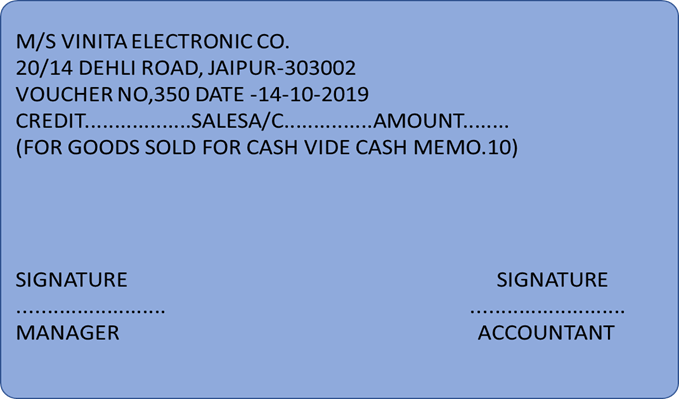
2. Accounting as a source of information
ACCOUNTING AS ASOURCE OF INFORMATION
Accounting is a definite process of interlinked activities, that begins with the identification of transactions and ends with the preparation of financial statements.
Every step in the process of accounting generates information.
Generation of information is not an end in itself. It is a means to facilitate the dissemination of information among different user groups.
Such information enables the interested parties to take appropriate decisions. Therefore, dissemination of information is an essential function of accounting.
To be useful, the accounting information should ensure to:
• provide information for making economic decisions;
• serve the users who rely on financial statements as their principal source of information;
• provide information useful for predicting and evaluating the amount, timing and uncertainty of potential cash-flows;
• provide information for judging management’s ability to utilize resources effectively in meeting goals;
• provide factual and interpretative information by disclosing underlying assumptions on matters subject to interpretation, evaluation, prediction, or estimation; and
• provide information on activities affecting the society.
USERS OF ACCOUNTING INFORMATION
Owners: The owners provide funds or capital for the organization. They possess curiosity in knowing whether the business is being conducted on sound lines or not, and
whether the capital is being employed properly or not. Owners, being businessmen, always keep an eye on the returns from the investment. Comparing the accounts of various years helps in getting good pieces of information.
Management: The management of the business is greatly interested in knowing the position of the firm. The accounts are the basis, the management can study the merits and
demerits of the business activity. Thus, the management is interested in financial accounting to find whether the business carried on is profitable or not. The financial accounting is the “eyes and ears of management and facilitates in drawing future course of action, further
expansion etc.”
-
Creditors: Creditors are the persons who supply goods on credit, or bankers or lenders of money. It is usual that these groups are interested to know the financial soundness before granting credit. The progress and prosperity of the firm, two which credits are extended, are largely watched by creditors from the point of view of security
and further credit. Profit and Loss Account and Balance Sheet are nerve centers to know the soundness of the firm
-
Employees: Payment of bonus depends upon the size of profit earned by the firm. The more important point is that the workers expect regular income for the bread. The demand for wage rise, bonus, better working conditions etc. depend upon the profitability of the firm and in turn depends upon financial position. For these reasons, this group is interested in accounting.
Investors: The prospective investors, who want to invest their money in a firm, of
course wish to see the progress and prosperity of the firm, before investing their amount, by going through the financial statements of the firm. This is to safeguard the investment. For this, this group is eager to go through the accounting which enables them to know the safety of investment.
Government: Government keeps a close watch on the firms which yield good amount of profits. The state and central Governments are interested in the financial statements to know the earnings for the purpose of taxation. To compile national accounting is essential.
Consumers: These groups are interested in getting the goods at reduced price. Therefore, they wish to know the establishment of a proper accounting control, which in turn will reduce to cost of production, in turn less price to be paid by the consumers.
Researchers are also interested in accounting for interpretation.
Research Scholars: Accounting information, being a mirror of the financial performance
of a business organization, is of immense value to the research scholar who wants to make a study into the financial operations of a particular firm as such study needs detailed accounting information relating to purchases, sales, expenses, cost of materials used, current assets, current liabilities, fixed assets, long-term liabilities and share-holders funds
-
The accounting system concerned only with the financial state of affairs and financial
results of operations.
-
It is the original form of accounting. It is mainly concerned with the preparation of financial statements for the use of outsiders like creditors, debenture holders, investors and financial institutions.
These users can be divided into two broad categories: internal users and external users.
Internal users include: Chief Executive, Financial Officer, Vice President, Business Unit Managers, Plant Managers, Store Managers, Line Supervisors, etc.
External users include: present and potential Investors (shareholders), Creditors (Banks and other Financial Institutions, Debenture holders and other Lenders), Tax Authorities, Regulatory Agencies (Department of Company Affairs, Registrar of Companies, Securities Exchange Board of India, Labour Unions, Trade Associations, Stock Exchange and Customers, etc.
2. Accounting as a source of information
- Books Name
- CA Shivali kedia Accountancy Book
- Publication
- CA Shivali kedia
- Course
- CBSE Class 11
- Subject
- Accountancy
Accounting as Source of Information
Accounting provides a) relevant information to users of financial statements, so that they can be b) informed decisions (On the basis of the financial statements). It helps users analyze the risks and uncertainties and ways to mitigate (minimize) them.
Let us understand the qualitative characteristics of Accounting!
Reliability
Imagine in our cafe Harsh has had an accountant. But the accountant is not a good person the accounting information expenses sales his recording are not true there all fall at the end of the year Harsh will not people to rely on that data is not true hence the first characteristic qualitative characteristic of data is it should be reliable and true
Relevance
The data has to be relevant to the user of the financial statements because data helps in making the decisions in the future data is the basis of making the decisions about the business in the future.
In short, no one can rely on decisions made when the accounts are all wrong and unreliable,
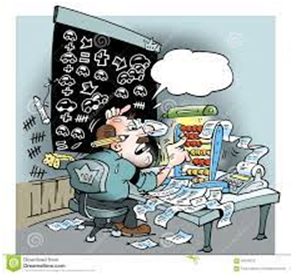
Understandability
In accountancy, we learn how to deal and interact with books of accounts and financial information. Sometimes there is no face-to-face communication between the accountant and the owner. At the end of the year, the accountant sometimes might just hand over the accounts to the owner.
Understandability explains refers to that the accounts should be prepared in such a way that even if there is no physical interaction the book of books of account should be self-explanatory to the person who is reading them understandability is very important for communication of financial information

Comparability
The accounting information should be comparable to the previous year’s information.
Sometimes the businesses compare their performance with the performance of similar companies in the industry.
Hence accounts should be prepared in such a way that they can be easily compared with in previous years and within our competitors as well
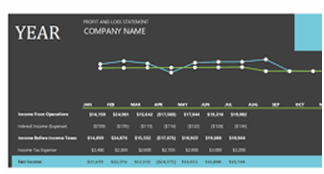
2. Accounting as a source of information
- Books Name
- Vision classes Accountancy Book
- Publication
- Vision classes
- Course
- CBSE Class 11
- Subject
- Accountancy
ACCOUNTING AS ASOURCE OF INFORMATION
Accounting is a definite process of interlinked activities that begins with the identification of transactions and ends with the preparation of financial statements.
Every step in the process of accounting generates information.
Generation of information is not an end in itself. It is a means to facilitate the dissemination of information among different user groups.
Such information enables the interested parties to take appropriate decisions. Therefore, dissemination of information is an essential function of accounting.
To be useful, the accounting information should ensure to:
• provide information for making economic decisions.
• serve the users who rely on financial statements as their principal source of information.
• provide information useful for predicting and evaluating the amount, timing and uncertainty of potential cash-flows.
• provide information for judging management’s ability to utilize resources effectively in meeting goals.
• provide factual and interpretative information by disclosing underlying assumptions on matters subject to interpretation, evaluation, prediction, or estimation.
• provide information on activities affecting the society.
3. Objectives of Accounting
OBJECTIVES OF ACCOUNTING
Objective of accounting may differ from business to business depending upon their specific requirements. However, the following are the general objectives of accounting.
• Keeping systematic record.
Accounting is used for the maintenance of a systematic record of all financial transactions in book of accounts. A proper and complete records of all business transactions are kept regularly. Moreover, the recorded information enables verifiability and acts as an evidence.
• Ascertain the results of the operation.
The owners of business are keen to have an idea about the net results of their business operations periodically, i.e. whether the business has earned profitsor incurred losses. Thus, another objective of accounting is to ascertain the profit earned or loss sustained by a business during an accounting period which can be easily workout with help of record of incomes and expenses relating to the business by preparing a profit or loss account for the period.
Profit represents excess of revenue (income), over expenses.
If the total revenue of a given period is Rs 6,00,000 and total expenses are Rs. 5,40,000 the profit will be equal to Rs. 60,000(Rs. 6,00,000 – Rs. 5,40,000).
If however, the total expenses exceed the total revenue, the difference reflects the loss.
• Ascertain the financial position of the business.
Accounting also aims at ascertaining the financial position of the business concern in the form of its assets and liabilities at the end of every accounting period. A proper record of resources owned by business organisation (Assets) and claims against such resources (Liabilities) facilitates the preparation of a statement known as balance sheet position statement.
• Portray the liquidity position.
Accounting liquidity measures the company’s debtor’s ability concerning their debt payments. The same is usually expressed in terms of the percentage of the current liabilities.
• To provide information to various parties.
The accounting information generated by the accounting process is communicated in the form of reports, statements, graphs and charts to the users who need it in different decision situations. As already stated, there are two main user groups, viz. internal users, mainly management, who needs timely information on cost of sales, profitability, etc. for planning, controlling and decision-making and external users who have limited authority, ability and resources to obtain the necessary information and have to rely on financial statements (Balance Sheet, Profit and Loss account).
• To facilitate rational decision – making.
Accounting records andfinancial statements provide financial information which help thebusiness in making rational decisions about the steps to be taken inrespect of various aspects of business.
• To satisfy the requirements of law
entities such as companies, societies, public trusts , are compulsorily required to maintain accounts as per the law governing their operations such as companies act, trust act, societies act etc. Maintenance of Accounts is also compulsory under sales tax act and income tax act.
3. Objectives of Accounting
- Books Name
- CA Shivali kedia Accountancy Book
- Publication
- CA Shivali kedia
- Course
- CBSE Class 11
- Subject
- Accountancy
Objectives of Accounting
The job of an accountant is to be able to maintain a systematic record of financial information namely journal ledger profitability and financial position
We have been introduced to the journal and ledger above in the definition of accounting
- The major objective of books of accounts accountancy is to calculate the profit earned or loss suffered in a given year. This is calculated by preparing a profit and loss account which you will learn in the course of this year
- Another important aspect of the objectives of accounting is to determine the financial position at the end of every year that is assets liabilities and capital at the end of the year.

Proper maintenance of books of accounts assists the management in planning and decision-making throughout the lifetime of the business
Note for students.
(As accounts students it is very important for us to understand the meaning of certain words.)
Quantitative
Quantitative data is something that is a number based which can be measured which can be counted.
For example how much salary does a CA make in a year?
Qualitative
Qualitative data relates to other than numbers characteristics.
For example, is the CA a girl or a boy
Is the CA hard working employee or a lazy one
3. Objectives of Accounting
- Books Name
- Vision classes Accountancy Book
- Publication
- Vision classes
- Course
- CBSE Class 11
- Subject
- Accountancy
OBJECTIVES OF ACCOUNTING
- Objective of accounting may differ from business to business depending upon their
- specific requirements. However, the following are the general objectives of accounting.
- Keeping systematic record.
- Ascertain the results of the operation.
- Ascertain the financial position of the business.
- Portray the liquidity position.
- To provide information to various parties.
- To facilitate rational decision – making.
- To satisfy the requirements of law
ACCOUNTING
- The object of accounting is to record, classify, summarize, analyze, and interpret the business transactions and ascertain financial results and to communicate to various parties.
- It has a wider scope.
- It is concerned with all levels of Management.
ADVANTAGES OF ACCOUNTING
- Replacement of memory
- Evidence court
- Assessment of taxation liability
- Comparative study
- Sale of business
- Assistance to the insolvent person
- Assistance to various parties
- Facilities in raising loans
- Information regarding financial position.
LIMITATIONS OF ACCOUNTING
- Records only monetary transactions.
- Unsuitable for forecasting.
- No realistic information
- Personal bias of the accountant affects the accounting statements .
- Incomplete information.
- Profit no real test of managerial performance .
- Historical in nature.
- Window dressing in balance sheet.
4. Role of Accounting
ROLE OF ACCOUNTING
For centuries, the role of accounting has been changing with the changes in economic development and increasing societal demands.
- It describes and analyses a mass of data of an enterprise through measurement, classification and summarization, and reduces those date into reports and statements, which show the financial condition and results of operations of that enterprise. Hence, it is regarded as a language of business.
- It also performs the service activity by providing quantitative financial information that helps the users in various ways.
- Accounting as an information system collects and communicates economic information about an enterprise to a wide variety of interested parties. However, accounting information relates to the past transactions and is quantitative and financial in nature, it does not provide qualitative and non-financial information. These limitations of accounting must be kept in view while making use of the accounting information.
MEANING AND DEFINITION OF BOOKKEEPING
- Definition: “The art keeping permanent record of business transactions is book keeping.”
- J. R. Batliboi: “book-keeping is an art of recording business dealings in a set of books”.
- R. N. Carter: “Book-keeping is the science and art of correctly recording in the books
of accounts, all those business transactions that results in transfer of money’s worth”.
FEATURES OF BOOK-KEEPING
- It is the process of recording business transactions.
- Monetary transactions are only recorded.
- Recording is made in given set of books of accounts.
- Record is prepared for a specific period but presented for future references.
- It is an art of recording business transactions scientifically.
DIFFERENCE B/W BOOK-KEEPING AND ACCOUNTING
BOOK-KEEPING
- The object of book-keeping is to prepare original books of accounts, trial balance and to maintain systematic record of financial results.
* It has a limited scope .
- Level of work is restricted to clerical work
ACCOUNTING
- The object of accounting is to record, classify, summarize, analyze, and interpret the business transactions and ascertain financial results and to communicate to various parties.
- It has a wider scope.
- It is concerned with all levels of Management.
ADVANTAGES OF ACCOUNTING
- Replacement of memory
- Evidence court
- Assessment of taxation liability
- Comparative study
- Sale of business
- Assistance to the insolvent person
- Assistance to various parties
- Facilities in raising loans
- Information regarding financial position.
LIMITATIONS OF ACCOUNTING
- Records only monetary transactions.
- Unsuitable for forecasting.
- No realistic information
- Personal bias of the accountant affects the accounting statements .
- Incomplete information.
- Profit no real test of managerial performance .
- Historical in nature.
- Window dressing in balance sheet.
4. Role of Accounting
- Books Name
- CA Shivali kedia Accountancy Book
- Publication
- CA Shivali kedia
- Course
- CBSE Class 11
- Subject
- Accountancy
Roles of Accounting
The keywords here are identifying measuring recording and communicating. Let us study this in a little bit of detail
1. Identifying relevant transactions
Depending on the size of the business and hundreds of transactions can take place in a single day. Not everything can be recorded in the books of account. For all these transactions the accountant has to identify those transactions which are related to the business which are monetary in nature and which will come in our books of accounts
Example: Suppose Harsh Buys a refrigerator for a home for Rs.50,000. Which is a Business Transaction.
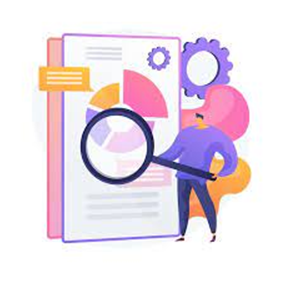
2. Measurement
Let us take a scenario where are trader trading in stationery items is selling the items within India and is also exporting some of his items to a dealer in China. What will be the common unit what will be the measuring unit will it be rupees will it be Paisa over let be a dollar a single unit common for all transactions has to be taken into account which is not to be changed every year.
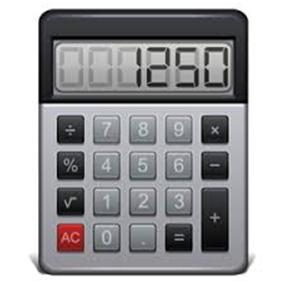
3. Recording

This is the basic (First) function of accounting for all business transactions all monetary (related to money) business transactions such as
Eg. sales purchases salaries and electricity are recorded or accounted in the books of account.
The recording is done in a book called journal which will study more in the coming chapters.
After the Accountant has recorded data the data has to be classified in a systematic manner,
similar accounts are grouped and placed in one place called a book called ledger this is the second step of recording
from journal we record the transactions all the transactions falling under the same head in an account called ledger which will study ahead in the coming chapters.
4. Communication
After the accounts has been recorded and measured analyzed the job of an accountant does it complete at this point.
Communication is concerned with transmitting the information to the end-users of financial statements so they can prepare to make decisions on the basis of books of accounts.

Why do the accountants need to communicate the results of the books of account or communicate the results of the books of accounts to the uses of financial statements who are these uses of financial statements let us understand?
There can be two kinds of uses of two financial statements. External users and internal users. People who are on the payroll (on salary) of the company are called internal uses to financial statements.

Internal users
If the company is growing, the employee’s growth is certain. The CEO the CFO vice president managers plant manager's there all internal to the organization and hence internal uses of the organization
External users
A business cannot function alone there are banks who give loans to the businesses there are creditors who give the gift credit to the businesses there is the government who keeps an eye if they are papering a taxes correctly or not the customer buys are products because he trusts us all these people are external to the organization they are dealing with the organization from the outside and external uses of financial information
Users Why do they need information?
Investors return on money invested in the business
Unions and employee groups Stability in Income, Bonus (Out of profits)
Lenders and Banks Credibility of the company
Creditor’s Continuous supply of products
Government and related Organisations Complaisance and payments of dues
Social Groups Impact on the environment
Other fields of accounting
Financial accounting refers to the preparation and interpretation of financial information and communication to the users of accounts. This is what we have understood above accounting is the basic sense
Management accounting refers to internal reporting to the management of the business. Management accountant is a very important component that helps the management make important decisions regarding the business operations
Cost accounting
Cost accountants are usually hired by companies that are dealing with manufacturing products. For any manufacturer cost of the product manufactured by him is the most important factor which decides his profits
All this tells you about the person or the data but not that they mention any quantity or numbers
Accounting has certain qualitative characteristics let us understand what qualitative characteristics are.
Accounting data should be recorded in such a way that it is very easy and understandable and useful to the person who uses that data.
For example, if I just randomly right 10 numbers it will not make any sense
But let’s say that these 10 numbers are the marks of the students in your class then it would make sense
4. Role of Accounting
- Books Name
- Vision classes Accountancy Book
- Publication
- Vision classes
- Course
- CBSE Class 11
- Subject
- Accountancy
ROLE OF ACCOUNTING
For centuries, the role of accounting has been changing with the changes in economic development and increasing societal demands.
It describes and analyses a mass of data of an enterprise through measurement, classification and summarization, and reduces those date into reports and statements, which show the financial condition and results of operations of that enterprise. Hence, it is regarded as a language of business.
It also performs the service activity by providing quantitative financial information that helps the users in various ways.
Accounting as an information system collects and communicates economic information about an enterprise to a wide variety of interested parties. However, accounting information relates to the past transactions and is quantitative and financial in nature, it does not provide qualitative and non-financial information. These limitations of accounting must be kept in view while making use of the accounting information.
USERS OF ACCOUNTING INFORMATION
Owners:
The owners provide funds or capital for the organization. They possess curiosity in knowing whether the business is being conducted on sound lines or not, and whether the capital is being employed properly or not. Owners, being businessmen, always keep an eye on the returns from the investment. Comparing the accounts of various years helps in getting good pieces of information.
Management:
The management of the business is greatly interested in knowing the position of the firm. The accounts are the basis, the management can study the merits and demerits of the business activity. Thus, the management is interested in financial accounting to find whether the business carried on is profitable or not. The financial accounting is the “eyes and ears of management and facilitates in drawing future course of action, further expansion etc.”
Creditors:
Creditors are the persons who supply goods on credit, or bankers or lenders of money. It is usual that these groups are interested to know the financial soundness before granting credit. The progress and prosperity of the firm, two which credits are extended, are largely watched by creditors from the point of view of security and further credit. Profit and Loss Account and Balance Sheet are nerve centers to know the soundness of the firm.
Employees:
Payment of bonus depends upon the size of profit earned by the firm. The more important point is that the workers expect regular income for the bread. The demand for wage rise, bonus, better working conditions etc. depend upon the profitability of the firm and in turn depends upon financial position. For these reasons, this group is interested in accounting.
Investors:
The prospective investors, who want to invest their money in a firm, of course wish to see the progress and prosperity of the firm, before investing their amount, by going through the financial statements of the firm. This is to safeguard the investment. For this, this group is eager to go through the accounting which enables them to know the safety of investment.
Government:
Government keeps a close watch on the firms which yield good amount of profits. The state and central Governments are interested in the financial statements to know the earnings for the purpose of taxation. To compile national accounting is essential.
Consumers:
These groups are interested in getting the goods at reduced price. Therefore, they wish to know the establishment of a proper accounting control, which in turn will reduce to cost of production, in turn less price to be paid by the consumers.
Researchers are also interested in accounting for interpretation.
Research Scholars:
Accounting information, being a mirror of the financial performance of a business organization, is of immense value to the research scholar who wants to make a study into the financial operations of a particular firm as such study needs detailed accounting information relating to purchases, sales, expenses, cost of materials used, current assets, current liabilities, fixed assets, long-term liabilities and share-holders funds.
- The accounting system concerned only with the financial state of affairs and financial results of operations.
- It is the original form of accounting. It is mainly concerned with the preparation of financial statements for the use of outsiders like creditors, debenture holders, investors and financial institutions.
MEANING AND DEFINITION OF BOOKKEEPING
Definition: “The art keeping permanent record of business transactions is book keeping.”
J. R. Batliboi: “book-keeping is an art of recording business dealings in a set of books”.
R. N. Carter: “Book-keeping is the science and art of correctly recording in the books of accounts, all those business transactions that results in transfer of money’s worth”.
FEATURES OF BOOK-KEEPING
- It is the process of recording business transactions.
- Monetary transactions are only recorded.
- Recording is made in given set of books of accounts.
- Record is prepared for a specific period but presented for future references.
- It is an art of recording business transactions scientifically.
DIFFERENCE B/W BOOK-KEEPING AND ACCOUNTING
BOOK-KEEPING
- The object of book-keeping is to prepare originalbooks of accounts, trial balance and to maintain systematic record of financial results.
- It has a limited scope.
- Level of work is restricted to clerical work
5. Basic terms in Accounting
BASIC TERMS USED IN ACCOUNTING
Entity
- An entity means an economic unit which performs economic activities e.g., Bajaj Auto,
- Maruti, TISCO.
Account
- It is a summarized record of
- relevant transactions at one place
- relating to a particular head. It records not only the amount of transactions
- but also reflect the direction of the account.
• ENTRY
- A transaction and event when recorded in the books of accounts is known as an Entry
• Transaction
- It is a financial happening entered into by two or more willing parties.
- It effects a change in the asset, liability, or net worth account.
- It is recorded first in journal and then posted into the ledger Examples of a transaction are sale of goods, purchases of goods, receipt from debtors, payment made to creditors,
- purchase or sale of fixed assets, payment of dividend, etc.
• Proprietor
- is the person who makes the investment and bears all the risks and rewards of the business
Debtor is
- a person or firm or company which owes amount to the enterprise on account of credit sale of goods or services.
- The amount due from him is a debt.
- The amount due from a person as per the books of the account is called a book debt.
• Drawings
- It is the amount of money or the value of goods which the proprietor or a partner takes for his domestic or personal use.
- Drawing reduces the investment (or capital) of the owners.
- It appears only in the accounts of sole proprietorship firms and partnership firms.
• Purchases
- The term purchases are used only for purchases of goods.
- Goods are those items which are purchased for resale or
- for manufacture of products which are also to be sold.
- It includes both cash and credit purchases
• Depreciation
- It is a fall in the value of an asset
- because of usage; or
- with passage of time; or
- obsolescence; or
- accident
• Purchases Return:
- Goods purchased may be returned due to any reason, say, they are not as per specifications or are defective.
- Goods returned are termed as Purchases Return or Returns Outward.
• Sale
- This term is used for the sale of goods dealt by the enterprise.
- The term ‘Sales’ includes both Cash and Credit Sales.
- When goods are sold for cash, they are cash sales
- When goods are sold and payment is to be received at a later date, they are credit sales.
• Sales Return or Returns Inwards
- It means Goods sold returned by the purchaser.
Discount
- A reduction in the price of goods is Discount.
Trade Discount
- It is a discount allowed to a customer on the basis of quantity of goods purchased.
Cash Discount
- It is a discount allowed to a customer for making prompt or timely payment.
• Capital
- It means the amount (in terms of money or assets having money value)
- Which the proprietor has invested in the business
- and can claim from it.
- It is a liability of the business towards the owner.
- It is so because of Business Entity Concept.
- Capital = Assets – Liabilities
• Gain
- It is a profit that arises from transactions which are incidental to business such as
- sale of investments or fixed assets
- at more than their book values.
- Gain may be operating gain or non-operating gain.
• Cost
- It is the amount of expenditure
- incurred on or
- attributable to
- a specified article, product or activity.
• Creditor is
- a person or firm or company to whom the enterprise owes amount on account of Credit purchase of goods or services.
• Assets:
- Assets are property or legal rights
- owned by an individual or business
- to which money value can be attached.
- In other words, anything which will enable the firm to get cash or a benefit in the future,
• Bad Debt
- It is the amount that has become irrecoverable
- It is a business loss, and
- Thus, is debited to Profit and Loss Account.
• Insolvent
- Insolvent is a person or an enterprise which is not in a position to pay its debts.
• Liabilities
- Liabilities means the amount
- which the business owes to outsiders,
- excepting the proprietors.
- Liabilities can be classified in
- (i) Long-Term Liabilities (ii) Current Liabilities,
- This can be expressed as: Liabilities = Assets – Capital
• Goods
- They refer to items forming part of the stock-in-trade of an enterprise,
- which are purchased or manufactured with a purpose of selling.
- In other words, they refer to the products in which an enterprise is dealing.
• Stock or Inventory
- Stock is the tangible property held by an enterprise
- for the purpose of sale in the ordinary course of business or
- for the purpose of using it in the production of goods
- meant for sale or services to be rendered.
- Stock may be opening stock or closing stock.
• Profit
- Profit is the surplus of revenues of a business over its costs.
- Profit is categorized into:
- Gross Profit: Gross Profit is the difference between sales revenue or the proceeds of goods sold and/or services rendered over its direct cost.
- Net Profit: Net Profit is the profit made after allowing for all expenses. In case expenses are more than the revenue; it is Net Loss.
• Loss
- Loss is excess of expenses over its related revenues which may arise from normal business activities.
- It decreases the owner’s equity.
- It also refers to money or money’s worth lost (or cost incurred) against which the enterprise receives no benefit, e.g., cash or goods lost in theft.
- It also arises from events of non-recurring nature, e.g., loss on sale of fixed assets
• Expense
- An expense is the amount spent in order to produce and sell the goods and services which produce the revenue.
- Expense is the cost of the use of things or services for the purpose of generating revenue.
- Expense is that part of the expenditure which has been consumed during the current accounting period.
- Examples of expense are payment of salaries, wages, rent, etc.
• Expenditure:
- An expenditure is the amount spent or liability incurred for the value received
- Expenditure may be categorised into: (i) Capital Expenditure (ii) Revenue Expenditure
- An expenditure is a payment (or a money sacrifice) for a benefit received.
• Capital Expenditure
- It is the amount spent in purchasing assets which will give benefit over more than one accounting period.
- It means expenditure incurred to acquire fixed assets or its improvement.
- Capital expenditure is debited to particular asset account.
- They appear at the assets side of the Balance Sheet.
• Revenue Expenditure
- It is the amount spent to purchase goods and services that are consumed during the accounting period.
- It is shown in the debit side of the Profit and Loss Account
• Revenue
- It is the gross inflow of cash, receivables or other consideration
- arising in the ordinary course of business activities
- from the sale of goods, rendering of services,
- and use by others of enterprise resources yielding interest, royalties and dividends
• Income:
- Income is the profit earned during an accounting period.
- In other words, the difference between revenue and expense is called income.
- Income = Revenue – Expense
5. Basic terms in Accounting
- Books Name
- CA Shivali kedia Accountancy Book
- Publication
- CA Shivali kedia
- Course
- CBSE Class 11
- Subject
- Accountancy
Basic Terms of Accounting
Follow the Story
17-year-old Harsh
Harsh is a commerce student in class 12th who is very confident and smart and wants to run a business like his father.

Although, he was average in his studies but had a smart business mind.
He wanted to start a business of opening a small café in his locality after his school.
He discussed this idea with his father.
His father wanted him to open this business but only if he pursues college along side

His father liked his business Idea and Gave him Rs.10 lacs to start the cafe

Exercise for students:
List down how will Harsh spend this 10 Lac Rupees to start his café.
1)_____________
2)_____________
3)_____________
4)_____________
5)_____________
6)_____________
7)____________
Starting the cafe
1) Place to run business (either Buy or Rent)
2) Hire a Cook and Staff (Salary)
•3)Raw materials (Breads, Eggs, vegetables)
•4) Griller, Deep freezer
•5) Registration and other expenses, etc
How many did you get right?
Accountancy is very closely related to practical and day-to-day life.
Let us understand the basic terms
Capital
Money which is invested by the Owner in starting the business is called capital.
Remember, when Harsh needed 10 Lacs rupees, his father gave him this money for free. Its Harsh’s (owners) money.
Harsh started his café with RsLacs of his own money, called capital which he does have to pay back to his father.

Assets
•Assets are resources which are owned by “Business” which has some value.
•In Harsh Story What are the items whchhasrh purchased (Which has a value)
•Deep freeze, Griller, oven, raw materials like cheese, bread, spices, etc
•If Harsh wants to see any of these, at any point, he will get some value.
•Assets are further classified into 2 broad categories
Assets Classification
Non Current Asset
•Some assets have a life of more than one year.
•Furniture, Air condition, Car, Truck, Plant and Machinery
•Land, Building, Long term investments etc
•We will talk more on this later
Current Assets
•On the other hand, some assets have a short shelf life
•Inventory (Stock), Debtors, Cash, Bank, Current investments
Liabilities
•Let us assume, that Harsh, spent all the 1Rs,10,00,000 and required 5 lacs more to run the business.
•He went to his father who refused to give him more money for the business

Harsh’s father asked him to reach out to the Bank.
Because Banks gives us loan repayable after a certain point.
Harsh will have to pay Interest on this loan

•Harsh gets 5 lac rupees from bank as Loan loan repayable in 5 years with 10% interest p.a

Although Harsh is happy that he got to money to start his business.

Please remember that he will have to pay back the bank this loan or bank will forfeit his assets.
This is a liability of Harsh’s Café, an obligation which needs to be paid in the future.

Liabilities classification
Non CurrentLiabilites
Bank Loans (Repayabale after1 year)
Other Long term loans
Current Liabilites
•Bank Loans (Repayable in less than 1 year)
•Creditors
•Bills Payable
Loan and capital ?
Capital
•Money which is invested by the Owner in starting the business is called capital.
•Example: Money Harsh received from his father which he doesn’t need to pay be to his father.
Loan
•Money invested in the business, which has to be repaid to a third party, after a point of time with interest is called Loan
•Example: Money Harsh received from Bank which has to be paud back after 5 years with interest.

Harsh successfully Opens his Café
Lets move ahead in our story!!
Sales
The café sells its first burger i.e. makes it first “SALE”
Sales are total Revenues from good and services sold to consumers in a given year.
Sales can be made in cash, called cash sales.
Sales can also be made on credit called credit sales
It’s the owners decision and industry standards on cash and credit sale depending on the product and service.
Sales and revenue
Sales
•Sales are total Revenues from good and services sold to consumers in a given year.
•Eg: Selling of Burgers and sandwiches in the café and taking service charge from customers for the services provided by the café
Revenue/Income
•Revenue is the sum total of Sales and other income
•Other Income includes income earned by business from sources, other than its “main operations”
•Example: Harsh’s café sells and old AC foe 15000. This 15000 is not sales but is “other income “for the café

Now the café became profitable. Lets understand how
Expenses

For generating sales, all the cost incurred by the business is called expenses.
In Harsh’s café, think of the expenses incurred to sell that one burger:
1)Salary to cook and staff2)Electricity expenses
3)Purchase of raw material
There are a lot of other expenses which I leave to the students to think and list.

Expenses and Expenditure
Expenses
•Costs incurred by business for generating sales. •It’s recurring in nature.
•Wages, salaries, electricity bill, water bills, repairs, purchases etc
•Expenses are subtracted from sales to calculate profits for the year.
Expenses are a yearly concept, that is, the benefit of this expense is exhausted within a year
Expenditure
•Cost incurred by business for some benefit, generating sales or acquiring property for business
•Wages, salaries, purchases, land purchased, revenue purchased
•The benefit of expenditure is not exhausted in one year.
If café purchases delivery scooter, the scooter will run for more than one year. The benefit accrues for more than one year unlike expenses
Profit = Revenue – Related expenses
•Related expenses means expenses reated to business. Eg: Salary, wages, etc.
•Unrelated expenses are expenses which are not related to business of café.
For the café, unrelated expenses eg. Repairs made for colony gate where café is situated

Profit and Gain
Profit
•Excess of revenue over related expenses is called Profit.
•If selling price of burger is Rs 500 and total cost of making that burger is Rs 200. Then profit will be Rs. 300.
Gain
•Gains are profit arising from a transaction which is not the main operations of the business
•For example: :Harsh’s café sells and old AC and made a profit of 5000. This 5000 will not be called proft but is gain to the business the café
Loss
The excess of expenses of a given period (Financial year) , over Income (Revenue) of a given period is called Loss.

In our Café,
1)let’s say Total Revenue for the year 2022-2023 is Rs, 12,00,000
2)Expenses of salaries, purchases of raw materials, bills is 14,00,000
3)So the the year 2022-2023, Harsh’s café made a loss of (2,00,000)
Inventory (Stock/Goods)
Inventory are goods used in production process, as well as, finished goods produced thereafter.
Inventory also includes good lying with the trading concerns where no production process is carried on.
In Harsh’s Café, the café used raw materials (eg: Vegetables, milk, bakery products) , to produced finished goods Eg: (Pizza, Sandwiches), etc. All these will be considered as Inventory

Goods and Stock
•Goods are the products which are being purchased and sold by the business. Goods and Inventory is often used interchangeably.
•Please note, there are various products which the business purchases in its day to day working. Such items are not categorised as goods, for example in Harsh café, stationary (like bill rolls, pens, stapler) will be purchased. These will not be categorised as goods.
•Inventory are goods used in production process, as well as, finished goods produced thereafter.
•Inventory also includes good lying with the trading concerns where no production process is carried on.
Drawings
No, Not what you are thinking!
These are not doodling or drawing, literally.
When the owner withdraws money or any other asset from business for his “ personal needs” is called Drawings.

In Harsh’s example,
Lets say, after making the business protitable, now he wants to take a vacation with his family to Paris. He withdraws Rs, 5,00,000 from the business Bank Account. These Rs, 5 lacs will be considered drawings in the accounts of the business.
Purchases
•Purchases are expense incurred by the owner on purchase of inventory, on cash or credit.
Note for Students: Don’t think about purchases you would make as an individual
•Think from the company's or proprietor’s viewpoint. It has to be a purchase the business
•In Harsh’s café, if you purchase a burger, it’s a Sale for the business.
•But the purchases made by the café to make that one burger will be a Purchase for the business.
Discount
•Consider this example,
•You are a friend of Harsh and you visit his café to have dinner with your family. You bill comes out to Rs. 2,500.
•Harsh Gives you a discount of 20% and you end up paying only Rs. 2,000.
•Harsh gave you a discount of Rs,500. It is a loss to the business.
•Discount is the reduction on the sale price of the sales.
•In Accounting Discount is of two kinds. Lets discuss this on the next slide
Trade Discount & Discount (Cash Discount
Trade Discount
•This discount is given when a customer places an order in bulk.
•Higher Sales orders are always preferred by sellers and businesses. To encourage that, Trade discount is given to the customer on bulk orders
Cash Discount
•Usually in businesses, Sale/purchase happen on a Credit basis, from buyers and sellers.
•If a customer is willing to make the puchase in Cash, they are given a discount. Because cash is a preferred mode of payment.
•Cash is dear to the business.
Debtors (Credit Sales)
•When a business makes a sale and agrees to the terms of receiving the sales value, at some future date from the customer, the customer becomes debtor of the company.
If a Harsh’s café sells a big order of Rs.10,000 to a customer (Mr. A) who agrees to clear the bill in one month’s time. Mr. A becomes the debtor to the company.
Creditor (Credit Purchases)
•When a business purchases goods from a seller, say Mr. X and agrees to pay Mr. X the money at a future date. Mr. X becomes a creditor to the business.
•It becomes a liability or obligation for the business to pa Mr. X at a future date.
•In our example:
•If Harsh’s café purchases bread on credit from the bakery owner and pay on later date (say end of every month).
•Then the Bakery owner will be accounted as Creditor in the books of harsh’s case Business.
Business Entity
Harsh Opened a Café and named it “Harsh’s Café”. He registered his business are a sole proprietorship (You will learn about this in class 11 business studies).
After he got his form registered, Harsh and Harsh’s café as 2 different persons in the eyes of law.
As soon as the owner registers the business, a new person is born in the eyes of the law, different from its owner.
Transaction
Transaction means an event or activity where one party is a receiver and other is a giver. It can be anything, like paying electricity bills, purchase of raw materials, making sales, etc

Voucher
Voucher is a evidence of the transaction in the court of law. Please look at the sales voucher below:
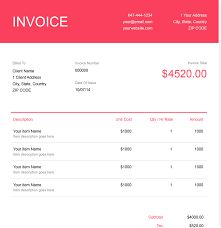
5. Basic terms in Accounting
- Books Name
- Vision classes Accountancy Book
- Publication
- Vision classes
- Course
- CBSE Class 11
- Subject
- Accountancy
BASIC TERMS USED IN ACCOUNTING
Entity
• An entity means an economic unit which performs economic activities e.g., Bajaj Auto, Maruti, TISCO.
Account
• It is a summarized record of
• Relevant transactions at one place
• relating to a particular head. It records not only the amount of transactions.
• But also reflect the direction of the account.
Entry
• A transaction and event when recorded in the books of accounts is known as an Entry.
Transaction
• It is a financial happening entered into by two or more willing parties.
• It effects a change in the asset, liability, or net worth account.
• It is recorded first in journal and then posted into the ledger Examples of a transaction are sale of goods, purchases of goods, receipt from debtors, payment made to creditors, purchase or sale of fixed assets, payment of dividend, etc.
Proprietor
• is the person who makes the investment and bears all the risks and rewards of the business.
Debtor
• A person or firm or company who owes amount to the enterprise on account of credit sale of goods or services.
• The amount due from him is a debt.
• The amount due from a person as per the books of the account is called a book debt.
Drawings
• It is the amount of money or the value of goods which the proprietor or a partner takes for his domestic or personal use.
• Drawing reduces the investment (or capital) of the owners.
• It appears only in the accounts of sole proprietorship firms and partnership firms.
Purchases
• The term purchases are used only for purchases of goods.
• Goods are those items which are purchased for resale or
• for manufacture of products which are also to be sold.
• It includes both cash and credit purchases
Depreciation
• It is a fall in the value of an asset
• Because of usage
• With passage of time
• Obsolescence
• Accident
Purchases Return:
• Goods purchased may be returned due to any reason, say, they are not as per specifications or are defective.
• Goods returned are termed as Purchases Return or Returns Outward.
Sale
• This term is used for the sale of goods dealt by the enterprise.
• The term ‘Sales’ includes both Cash and Credit Sales.
• When goods are sold for cash, they are cash sales
• When goods are sold and payment is to be received at a later date, they are credit sales.
Sales Return or Returns Inwards
• It means Goods sold returned by the purchaser.
Discount
• A reduction in the price of goods is Discount.
Trade Discount
• It is a discount allowed to a customer on the basis of quantity of goods purchased.
Cash Discount
• It is a discount allowed to a customer for making prompt or timely payment.
Capital
• It means the amount (in terms of money or assets having money value)
• Which the proprietor has invested in the business
• can claim from it.
• It is a liability of the business towards the owner.
• It is so because of Business Entity Concept.
• Capital = Assets – Liabilities
Gain
• It is a profit that arises from transactions which are incidental to business such as
• sale of investments or fixed assets
• at more than their book values.
• Gain may be operating gain or non-operating gain.
Cost
• It is the amount of expenditure
• incurred on or
• Attributable to
• A specified article, product or activity.
Creditor
• A person or firm or company to whom the enterprise owes amount on account of Credit purchase of goods or services.
Assets:
• Assets are property or legal rights
• owned by an individual or business
• to which money value can be attached.
• In other words, anything which will enable the firm to get cash or a benefit in the future,
Bad Debt
• It is the amount that has become irrecoverable
• It is a business loss, and
• Thus, is debited to Profit and Loss Account.
Insolvent
• Insolvent is a person or an enterprise which is not in a position to pay its debts.
Liabilities
• Liabilities means the amount
• Which the business owes to outsiders,
• Excepting the proprietors.
• Liabilities can be classified in
(i) Long-Term Liabilities
(ii) Current Liabilities,
• This can be expressed as: Liabilities = Assets – Capital
Goods
• They refer to items forming part of the stock-in-trade of an enterprise,
• Which are purchased or manufactured with a purpose of selling.
• In other words, they refer to the products in which an enterprise is dealing.
Stock or Inventory
• Stock is the tangible property held by an enterprise
• For the purpose of sale in the ordinary course of business or
• For the purpose of using it in the production of goods
• meant for sale or services to be rendered.
• Stock may be opening stock or closing stock.
Profit
• Profit is the surplus of revenues of a business over its costs.
Profit is categorized into:
(i) Gross Profit: Gross Profit is the difference between sales revenue or the proceeds of goods sold and/or services rendered over its direct cost.
(ii) Net Profit: Net Profit is the profit made after allowing for all expenses. In case expenses are more than the revenue; it is Net Loss.
Loss
• Loss is excess of expenses over its related revenues which may arise from normal business activities.
• It decreases the owner’s equity.
• It also refers to money or money’s worth lost (or cost incurred) against which the enterprise receives no benefit, e.g., cash or goods lost in theft.
• It also arises from events of non-recurring nature, e.g., loss on sale of fixed assets.
Expense
• An expense is the amount spent in order to produce and sell the goods and services which produce the revenue.
• Expense is the cost of the use of things or services for the purpose of generating revenue.
• Expense is that part of the expenditure which has been consumed during the current accounting period.
• Examples of expense are payment of salaries, wages, rent, etc.
Expenditure:
• Expenditure is the amount spent or liability incurred for the value received
• Expenditure may be categorized into: (i) Capital Expenditure (ii) Revenue Expenditure
• Expenditure is a payment (or a money sacrifice) for a benefit received.
Capital Expenditure
• It is the amount spent in purchasing assets which will give benefit over more than one accounting period.
• It means expenditure incurred to acquire fixed assets or its improvement.
• Capital expenditure is debited to particular asset account.
• They appear at the assets side of the Balance Sheet.
Revenue Expenditure
• It is the amount spent to purchase goods and services that are consumed during the accounting period.
• It is shown in the debit side of the Profit and Loss Account.
Revenue
• It is the gross inflow of cash, receivables or other consideration.
• arising in the ordinary course of business activities.
• From the sale of goods, rendering of services.
• Use by others of enterprise resources yielding interest, royalties and dividends.
Income:
• Income is the profit earned during an accounting period.
• In other words, the difference between revenue and expense is called income.
• Income = Revenue – Expense
3. System of Accounting
- Books Name
- Vision classes Accountancy Book
- Publication
- Vision classes
- Course
- CBSE Class 11
- Subject
- Accountancy
System accounting
The systems of recording transactions in the book of accounts are generally classified into two types, viz. Double entry system and Single entry system. Double entry system is based on the principle of “Dual Aspect” which states that every transaction has two effects, viz. receiving of a benefit and giving of a benefit. Each transaction, therefore, involves two or more accounts and is recorded at different places in the ledger. The basic principle followed is that every debit must have a corresponding credit. Thus, one account is debited and the other is credited. Double entry system is a complete system as both the aspects of a transaction are recorded in the book of accounts. The system is accurate and more reliable as the possibilities of frauds and mis-appropriations are minimised. The arithmetic inaccuracies in records can mostly be checked by preparing the trial balance.
The system of double entry can be implemented by big as well as small organisations. Single entry system is not a complete system of maintaining records of financial transactions. It does not record two-fold effect of each and every transaction. Instead of maintaining all the accounts, only personal accounts and cash book are maintained under this system. In fact, this is not a system but a lack of system as no uniformity is maintained in the recording of transactions. For some transactions, only one aspect is recorded, for others, both the aspects are recorded. The accounts maintained under this system are incomplete and unsystematic and therefore, not reliable. The system is, however, followed by small business firms as it is very simple and flexible (you will study about them in detail later in this book).
Business Transactions
An exchange of goods or services for cash or on credit by the business with outsiders is called a transaction. In the words of L. C. Copper, “A person’s dealings in money or money’s worth are termed as transactions.”
Entity: - Business entity means a specific identifiable business enterprise like Tata, Reliance, Amul, Sony etc.
Transactions: - Exchange of goods and services for consideration.
Assets: - These are properties or economic resources of an enterprises which can be expressed in monetary terms it can be divided in two parts
(a) Non-Current Assets: Fixed assets: Tangible & Intangible (more than 1 year period)
- Tangible Assets
- Land and Building
- Plant and Machinery
- Furniture
- Office Equipments
- Intangible Assets
- Goodwill
- Patents
- Trademarks
- Copyright
- Computer software
(b) Current assets (less than 1 year period)
- Debtors
- Bills Receivable
- Cash in hand
- Cash at bank
- Cheque in hand
- Drafts in hand
- Stock
- Prepaid Expenses
Definition of Assets
“Assets are future economic benefits, the rights, which are owned or controlled by an organization or individual.” -- Finney and Miller “Assets are property or legal right owned by an individual or a company to which money value can be attached.” -- R. Brockington According to Institute of Certified Public Accountants, U.S.A; “Current Assets include cash and other assets or resources commonly identified as those which are reasonably expected to be realized in cash or sold or consumed during the normal operating cycle of the business.”
Liabilities:
These are certain obligations or dues which firm has to pay. Liabilities can be divided into two categories i.e.,Non-Current Liabilities and Current Liabilities.
Non-Current Liabilities
- Bank Loan
- Mortgage
- Loan from other financial institutions
- Other long-term liabilities
Current Liabilities
- Creditors
- Bills Payable
- Outstanding Expenses
- Bank overdraft
Trade Receivables: Debtors + Bills Receivables
Debtors: - There are persons who owe to an enterprise an amount for buying goods and services on credit.
Bills Receivables: Amount to be received againt B/R (from debtors).
Trade Payable: Creditors + Bills Payable.
Creditors: - These are persons who have to be paid by an enterprise an amount for providing the enterprise goods and services on credit.
Bills Payable: Amount payable against the bills (to the creditors).
Capital: It is an essential investment for commencement of every business.
Sales: It can be credit or cash, in which goods are delivered to customers: (a) Cash Sales (b) Credit Sales.
Revenues: -It is the amount which is earned by selling of products.
Expense: -It is known as cost of assets consumed or services which used.
Expenditure: -It means spending money for some benefit.
Profit: - Excess of revenues over expenses is called profit.
Gain: - It generates from incidental transaction such as sales of fixed asset, winning of court case.
Loss: - Excess of expenses over income is termed as loss.
Discount: -It is defined as concession or deduction in price of goods sold.
Voucher: -It is known as evidence in support of a transaction.
Goods: - It refers all the tangible goods (Raw material, work in progress, finished goods.)
Drawings: - Amount of goods or cash which is withdrawn from business for personal use.
Purchases: - It means of procurement of goods on credit or cash.
Stock: - It is a part of unsold goods. It can be divided into two categories.
1. Opening stock
2. Closing stock.
Balance Sheet: Balance Sheet is prepared at the end of each accounting period to ascertain the financial position of the business.
Format of Balance Sheet

Capital expenditure:
“Outlay resulting in the increase or acquisition of an asset or increase in the earning capacity of the business is capital expenses”. William pickles
Benefit of this expenditure we [business] enjoy for a long time. Capital expenditure is incurred for the purpose of enjoying long term advantage for the business.
This expenditure is mostly incurred for buying assets [tangible or intangible] which can later to be sold and converted into cash.
This expenditure is incurred to increase the earning capacity of the business.
Some examples of capital expenditure:
- Expenditure which are only for acquisition of fixed Assets
- Expenditure which are used for the extension or improvement in fixed Assets
- Legal charges incurred
- purchase of land, building,
- Purchase of furniture,
- Or any fixed asset for permanent use in the business.
Revenue expenditure: Mostly benefit of this expenditure we [business] enjoy only within the current year. Expenses of administration, manufacturing, selling expense, Office expense and all day to day expenses of the current year, are example of revenue expenditure.
According to Kohlar, it is “an expenditure charged against operation: a term used to contrast with capital expenditure.”
3. System of Accounting
- Books Name
- CA Shivali kedia Accountancy Book
- Publication
- CA Shivali kedia
- Course
- CBSE Class 11
- Subject
- Accountancy
There are 2 systems of Accounting
- Double Entry System
Every transaction has 2 effects (Debit and Credit).
Eg 1: One person is receiving, another person is giving
Eg. 2: Suppose Ramesh purchases an office table by giving cash; the office table is coming in and cash is going out.
- Single Entry System
Because every transaction has 2 sides; maintaining accounts on the basis of a Single entry is not considered reliable under the Companies Act 2013. Although small businessmen adopt this method for ease of Accounting.
4. Basis of Accounting
Basis of Accounting:1. Cash Basis of Accounting 2. Accrual Basis of Accounting
Cash Basis of Accounting:
Under this method only cash transactions are recorded in the books of accounts. Entries are made only if cash is received or paid.
Accrual Basis of Accounting:
Under this method all transactions are recorded in the books of accounts (Cash and Non-Cash). Entries are made on the Accrual basis, it means cash and Non-cash both transactions are recorded in the books of accounts.
Source of Documents
All financial transactions are recorded in the books of accounts on the basis of source document or on the basis of some evidence. Source documents are helpful to prove that a transaction is actually made or not.
Cash Memo: Cash Memo is A bill of sale, it is a written document by a 'seller' to a purchaser,
reporting that on a specific date, a particular sum of money or other "value received",
Invoice or Bill : When goods are sold on credit, An invoice or bill is issued on the name of the buyer, indicating the products, quantities, and agreed prices for products or services, the seller has provided the buyer.
Receipt : A receipt is a written acknowledgment that a specified a sum of money has been received from the customer as an exchange for goods or services. The receipt is evidence of purchase of the goods or service.
Pay-in-Slip : Pay in slip is a form that is filled when the money is deposited by a customer in to his bank account.
Cheque: A cheque is a document (usually a piece of paper) that orders a payment of money. The
person writing the cheque, the drawer, usually has a account where the money is deposited.
Debit Note : When we return goods back to the supplier, a debit not is made on the name of
supplier, it means his account his debited. Debit Note proves that a debit entry has been made to a
debtor's or creditor's account.
Credit Note: When we receive goods back from our customer, then a credit not is made on the
name of the customer, it means customer’s account is credited.
Meaning of Voucher : Voucher is the documentary proof or evidence in support of a transaction.
For example when we purchase goods for cash, we get cash memo, and when we purchase goods
on credit, we get an invoice, when we make payment we get Receipt.
Types of Vouchers
There are two types of vouchers a) Cash Voucher b) Non Cash Voucher
Cash Vouchers: Cash vouchers are prepared for cash transactions only, when cash is received or
paid. There are two types of cash vouchers: a) Debit Vouchers b) Credit Vouchers
Debit Vouchers: Debit vouchers are prepared only for cash payments
Credit Vouchers : Credit vouchers are the opposite side of debit vouchers, Credit vouchers are prepared when we receive cash
Preparation of accounting vouchers: All business transactions recorded in the books of
accounts can be compared with the source documents. Accounts are debited or credited on the
basis of these source documents. After deciding, that what to be debited or credited, the next step
is the preparation of the vouchers.
Meaning of Accounting Equation
The Accounting Equation' is based on the double-entry book keeping system. For every debit there must be a credit. The accounting equation states that the sum of the Total assets must be equal to the sum of the liabilities.
Assets = Liabilities + Capital
Or
Capital = Assets - Liabilities
Or
Liabilities = Assets - Capital
Or
Assets = Total Liabilities or Total Equity
Or
Total Assets = Internal Liabilities + External Liabilities
4. Basis of Accounting
- Books Name
- Vision classes Accountancy Book
- Publication
- Vision classes
- Course
- CBSE Class 11
- Subject
- Accountancy
Basis of Accounting:
Cash Basis of Accounting: Under this method only cash transactions are recorded in the books of accounts. Entries are made only if cash is received or paid.
Accrual Basis of Accounting: Under this method all transactions are recorded in the books of accounts (Cash and Non-Cash). Entries are made on the Accrual basis, it means cash and Non-cash both transactions are recorded in the books of accounts.
Source of Documents
All financial transactions are recorded in the books of accounts on the basis of source document or on the basis of some evidence. Source documents are helpful to prove that a transaction is actually made or not.
Cash Memo: Cash Memo is A bill of sale, it is a written document by a 'seller' to a purchaser, reporting that on a specific date, a particular sum of money or other "value received",
Invoice or Bill: When goods are sold on credit, An invoice or bill is issued on the name of the buyer, indicating the products, quantities, and agreed prices for products or services, the seller has provided the buyer.
Receipt: A receipt is a written acknowledgment that a specified a sum of money has been received from the customer as an exchange for goods or services. The receipt is evidence of purchase of the goods or service.
Pay-in-Slip: Pay in slip is a form that is filled when the money is deposited by a customer in to his bank account.
Cheque: A cheque is a document (usually a piece of paper) that orders a payment of money. The person writing the cheque, the drawer, usually has a account where the money is deposited.
Debit Note: When we return goods back to the supplier, a debit not is made on the name of supplier, it means his account his debited. Debit Note proves that a debit entry has been made to a debtor's or creditor's account.
Credit Note: When we receive goods back from our customer, then a credit not is made on the name of the customer, it means customer’s account is credited.
Meaning of Voucher: Voucher is the documentary proof or evidence in support of a transaction. For example when we purchase goods for cash, we get cash memo, and when we purchase goods on credit, we get an invoice, when we make payment we get Receipt.
Types of Vouchers
There are two types of vouchers a) Cash Voucher b) Non Cash Voucher
Cash Vouchers: Cash vouchers are prepared for cash transactions only, when cash is received or paid. There are two types of cash vouchers: a) Debit Vouchers b) Credit Vouchers
Debit Vouchers: Debit vouchers are prepared only for cash payments.
Credit Vouchers : Credit vouchers are the opposite side of debit vouchers, Credit vouchers are prepared when we receive cash
Preparation of accounting vouchers: All business transactions recorded in the books of accounts can be compared with the source documents. Accounts are debited or credited on the basis of these source documents. After deciding, that what to be debited or credited, the next step is the preparation of the vouchers.
Meaning of Accounting Equation
The Accounting Equation' is based on the double-entry book keeping system. For every debit there must be a credit. The accounting equation states that the sum of the Total assets must be equal to the sum of the liabilities.
Assets = Liabilities + Capital
Or
Capital = Assets - Liabilities
Or
Liabilities = Assets - Capital
Or
Assets = Total Liabilities or Total Equity
Or
Total Assets = Internal Liabilities + External Liabilities
4. Basis of Accounting
- Books Name
- CA Shivali kedia Accountancy Book
- Publication
- CA Shivali kedia
- Course
- CBSE Class 11
- Subject
- Accountancy
Please read the case study
Suppose the grocery owner pay the rent of Rs.1000 per month. Yearly rent comes out to be 1000×12 that is Rs.12,000 annually. COVID-19 affected a lot of businesses so the grocery owner could not be six
months of rent. COVID-19 affected a lot of businesses so the grocery owner could not be six months of rent. So in the current year the grocery owner paid six months’ rent that is 6000 in cash be next year And 6000 is outstanding which will pay next year
There are 2 basis of Accounting 1) Cash basis Accounting And Accrual Basis Accounting
Cash Basis Accounting: Cash basis is the simplest form of accounting. Suppose you are a small businessman who owns a grocery shop. Under cash basis accounting all the shop owner needs to do is add all the cash coming in in one year and subtract all the cash he’s which is going out as payments. It can be a profit or loss.
Under cash basis accounting the owner will record the cash only cash payments that are he will record a rent of 6000. In cash basis accounting full 12 months’ rent is not charged here. If hundred percent of rent is not charged then I will be getting the correct profit? This is the reason companies act 2013 does not allow a company to prepare its books on the basis of cash basis accounting. Cash basis accounting is only followed by a very small business man
Accrual Basis of Accounting
Under accrual basis accounting the companies act 2013 requires the owner to charge all the incomes and expenses of 12 months so that the correct profit for 12 months can be arrived.
So here irrespective of how much cash has been paid for rent we will record the entire 12,000 as rent in arriving the profit/loss for the year.
There are 4 Accounts Relating to Accrual concept which we will study in the next chapter.
Outstanding Expenses, Prepaid expenses, Accrued Income and Unearned Income.
5. Accounting Standards
Accounting Standards
History and Development of Accounting Standards
The International Accounting Standards Committee (IASC) came into existence on 29th June 1973.
The main objectives of IASC are to develop the accounting standards. In India the Institute of
Charted Accountants of India (ICAI) had constituted the ‘Accounting Standards Board’ in April
1977 for developing the Accounting Standards
Meaning of Accounting Standards:
Accounting standards are the rules in written form that ensure the uniformity of accounting Standards, and provide guidance for the preparation, presentation and reporting of accounting information.
Features/Characteristics/Nature of Accounting Standards:
a) Provide Guidance to the Accountants ;
b) Brings Uniformity;
c) Accounting Standards are flexible ;
d) Provide information
Advantages of Accounting Standards
a) Helpful in bringing the uniformity
b) Helpful in improving the reliability of financial statements
c) Helpful in resolving the conflicts among the users of financial information.
Accounting Standards issued by the ICAI: Amendment is made recently in the section 211 of
companies act 1956. According to this amendment, the financial statements (Profit and Loss
Account and Balance Sheet) of a company should comply with the Accounting Standards. The
Council of the Institute of Charted Accountants of India has so far issued the following 32
Accounting Standards (AS).
Process of Accounting:
(1) Collecting and identifying financial transactions
(2) Recording
(3) Classifying
(4) Summarizing
(5) Deals with financial transactions
(6) Analysis and Interpretation
(7) Communicates
5. Accounting Standards
- Books Name
- Vision classes Accountancy Book
- Publication
- Vision classes
- Course
- CBSE Class 11
- Subject
- Accountancy
Accounting Standards
History and Development of Accounting Standards
The International Accounting Standards Committee (IASC) came into existence on 29th June 1973. The main objectives of IASC are to develop the accounting standards. In India the Institute of Charted Accountants of India (ICAI) had constituted the ‘Accounting Standards Board’ in April 1977 for developing the Accounting Standards
Meaning of Accounting Standards:
Accounting standards are the rules in written form that ensure the uniformity of accounting Standards, and provide guidance for the preparation, presentation and reporting of accounting information.
Features/Characteristics/Nature of Accounting Standards:
a) Provide Guidance to the Accountants.
b) Brings Uniformity.
c) Accounting Standards are flexible.
d) Provide information.
Advantages of Accounting Standards
a) Helpful in bringing the uniformity.
b) Helpful in improving the reliability of financial statements.
c) Helpful in resolving the conflicts among the users of financial information.
Accounting Standards issued by the ICAI:
Amendment is made recently in the section 211 of companies act 1956. According to this amendment, the financial statements (Profit and Loss Account and Balance Sheet) of a company should comply with the Accounting Standards. The Council of the Institute of Charted Accountants of India has so far issued the following 32 Accounting Standards (AS).
Process of Accounting:
- Collecting and identifying financial transactions
- Recording
- Classifying
- Summarizing
- Deals with financial transactions
- Analysis and Interpretation
- Communicates
5. Accounting Standards
- Books Name
- CA Shivali kedia Accountancy Book
- Publication
- CA Shivali kedia
- Course
- CBSE Class 11
- Subject
- Accountancy
The Institute of Chartered Accountants of India defines Accounting Standards as
The written policy documents issued by the expert accounting body cover the aspects of recognition measurement presentation and disclosure of accounting transactions in financial statements.
Accounting standard lays down standard accounting policies valuation techniques and disclosure requirements. It helps with comparing the financial statements of the company with other companies.
Benefits of accounting standards
By following accounting standards the accountant has the following benefits of accounting standards by setting accounting standards the accountant has the following benefits
- Eliminate confusing variations in accounting treatment used to prepare accounting statements
- Standards make the call for disclosures in the financial statements which are not required by law and is always better for the user of financial statements.
- Accounting standards facilitates makes possible comparison of financial statements of companies situated in different parts of the world. For example, the financial statements of Pizza Hut in India and Pizza Hut in the US will be comparable because of accounting standards
Limitations of Accounting Standards
- Accounting standards give solutions and choices between alternative accounting treatments. The accountants find it difficult to make a choice between these different treatments
- Accounting standards cannot override the statute the standards or to be framed or made with a restricted scope
Applicability of accounting standards (Who all need to follow as)
- Sole Proprietor
- Joint Hindu Undivided Family
- Trusts
- Societies
- Cooperatives
- Companies
- Association of persons
Basically, ALL forms of business organizations need to follow AS.
Need for Accounting Standards
- Accounting standards make the financial statements of different companies, across different countries comparable with each other.
- Accounting standards help us provide full information as the standards focus on full disclosure of information in the financial statements
- Accounting standards provide us with various alternate accounting solutions and treatments which can be followed by the entity
2. Accounting Equation
- Books Name
- Vision classes Accountancy Book
- Publication
- Vision classes
- Course
- CBSE Class 11
- Subject
- Accountancy
Accounting Equation:
The accounting equation is the basic element of the balance sheet and the primary principle of accounting. It helps the company to prepare a balance sheet and see if the entire enterprise’s asset is equal to its liabilities and stockholder equity. It is the base of the double-entry accounting system.
Double-entry accounting is a system that ensures that accounting and transaction equation should be equal as it affects both sides. Any change in the asset account, there should be a change in related liability and stockholder’s equity account. While performing journal entries accounting equation should be kept in mind.
Total Assets =Total Liabilities
OR
Total Assets = Internal Liabilities + External Liabilities
OR
Total Assets = Capital + Liabilities
Examples of accounting equation
1) Ram started business with cash rs.10000
Assets (cash+) = liabilities (capital+) +10000 = +10000
Its mean assets increase and liabilities also increase same amount so result will be same
2) mohan purchase good with cash rs.1000
Assets (stock+) asset (cash-) =liabilities +1000 -1000
3) Goods sold to shyam on credit for rs.5000
Assets (stock-) assets (debtors+) = lia. (No change)
4) Furniture purchase for cash rs.25000
Assets (furniture+) assets (cash) = lia. (No change)
5) Paid rent rs.500
Assets (cash-) = liabilities (capital-)
6) Received commission rs.400
Assets (cash+) = lia. (Capital+)
Multiple effect entries
Goods sold on credit (cost price rs.30000) for Rs. 40000
Assets (stock-) assets (debtors+) = lia. (capital+)
-30000 + 40000 = + 10000
Classification of Transactions Following are the nine basic transactions:
1. Increase in assets with corresponding increase in capital.
2. Increase in assets with corresponding increase in liabilities.
3. Decrease in assets with corresponding decrease in capital.
4. Decrease in assets with corresponding decrease in liabilities.
5. Increase and decrease in assets.
6. Increase and decrease in liabilities
7. Increase and decrease in capital
8. Increase in liabilities and decrease in capital
9. Increase in capital and decrease in liabilities.
Example :
Show the effect of the following business transactions on assets, liabilities and capital through accounting equations:
1. Commenced business with cash 20,000
2. Goods purchased on credit 7,000
3. Furniture purchased 3,000
4. paid to creditors 2,000
5. Amount withdrawn by the proprietor 4,000
6. Creditors accepted a bill for payment 1,500
7. Interest on capital 1,000
8. Transfer from capital to loan 5,000
9. Allotted shares to creditors 1,000
Solution:
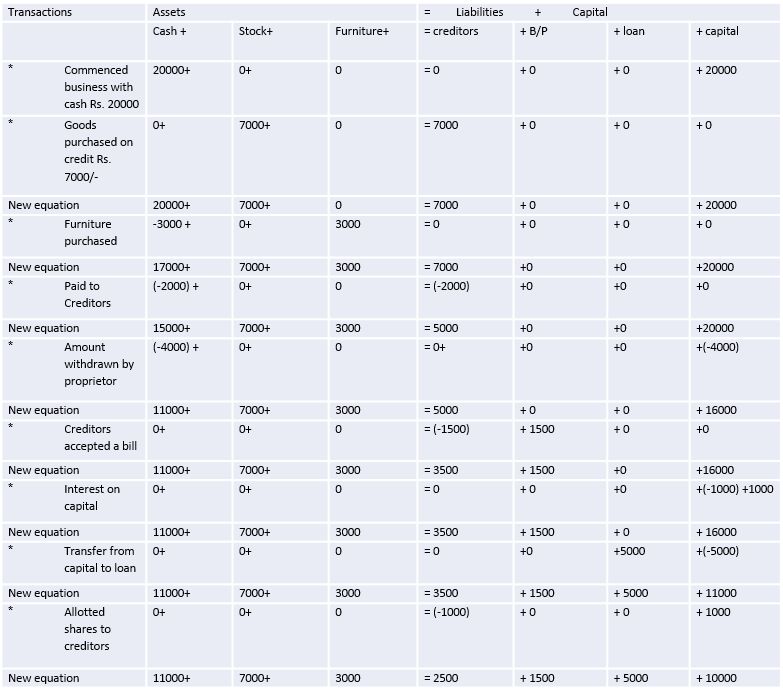
Important note
Assets = Liabilities +Capital
Assets are equal to the sum total of Liabilities and Capital
Question for Practice:
Prepare Accounting equation on the basis of following information:
(1) Sohan started business with cash =80,000
Machinery =10,000
And stock =10,000
(2) Interest on the above capital was allowed @10%
(3) Money withdrew from the business for his personal use10, 000
(4) Interest on drawings 500
(5) Depreciation charged on machinery 2,000
3. Using Debit & Credit
- Books Name
- Vision classes Accountancy Book
- Publication
- Vision classes
- Course
- CBSE Class 11
- Subject
- Accountancy
USING DEBIT AND CREDIT
Rules of Debit and Credit
Traditional or English Approach: This approach is based on the main principle of double entry system i.e., every debit has a credit and every credit has a debit. According to this system we should record both the aspects of a transaction whereas one aspect of a transaction will be debited and other aspect of a transaction will be credited.
(1) Personal Account: The accounts which related to an individual, firms, company, or an institution.
Personal account classified three categories:
(i) Natural person accounts -Mohan, Seeta, bank, capital, and drawing. Debtors, creditors account
(ii) Artificial personal accounts-company, firms and institutions.
(iii) Representative personal accounts- outstanding expenses, prepaid expenses, accord income and received in advance.
RULE
Debit - the receiver
Credit - the giver
(2) Real Account: The account all of those things whose value can be measure term of money like cash, goods, furniture, goodwill etc.
RULE
Debit what comes in
Credit what goes out.
(3) Nominal Account: these accounts include the account of all expenses and incomes. Like rent, salary, interest, commission, discount received/allowed etc.
RULE
Debit all expenses & losses
Credit all incomes and gains.
(2) Debit and Credit rules (Modern or American Approach)
This approach is based on the accounting equation or balance sheet. In this approach accounts are debited or credited according to the nature of an account. In a summarized way the five rules of modern approach is as follows:
1. Increase in asset will be debited and decrease will be credited.
2. Increase in the liabilities will be credited and decrease will be debited.
3. Increase in the capital will be credited and decrease will be debited.
4. Increase in the revenue or income will be credited and decrease will be debited.
5. Increase in expenses and losses will be debited and decrease will be credited.
IMPORTANT NOTE:
1. Increase in Assets/ Expenses and Losses will be debited and decrease will be credited
2. Increase in Liabilities/ capital/ Revenue or Gain will be credited and decrease will be debited
4. Books of original entry
- Books Name
- Vision classes Accountancy Book
- Publication
- Vision classes
- Course
- CBSE Class 11
- Subject
- Accountancy
Books of Original Entry
When a businessman starts their company, one of the primary things they do is keep a track of their everyday transactions. These transactions are recorded on a timely basis (depending on the nature of their business) in a book before they are transferred to ledger accounts. Books of original entry are nothing but an accounting book or journal where all transactions are initially recorded. All business transactions, their details and descriptions are first recorded in the book of original entry.
Entering transactions on a regular basis in Book of original entry that carries details and evidence of business transactions before they are posted or transferred into proper ledger because, without the book of original entry being filled with evidence of business transactions, the writing of a ledger cannot be initiated.
Types of Books of Original Entry:
- General Journal - To record the transactions not recorded in special journals
- Special Journals - Special journals include further sub-journals; as given below:
- Sales journal - To record sales invoices issued by the firm when selling goods on credit
- Purchases journal - To record purchases invoices received by the business from suppliers, when buying goods on credit
- Return inwards journal - To record sales returns from customers
- Return outwards journal - To record purchases returns to suppliers
- Cash book - To record receipts or payments
Entries in the books of original entry normally consist of:
- Date of transaction
- Details relating to transactions, i.e., the second aspect of transactions, e.g., name of trade receivable in the sales journal
- Monetary amount of the transactions
- References to the relevant ledger account (often called folio)
- References to original source documents, e.g., invoice number
5. Journal and Ledger
- Books Name
- Vision classes Accountancy Book
- Publication
- Vision classes
- Course
- CBSE Class 11
- Subject
- Accountancy
Journal
This is the basic book of original entry. In this book, transactions are recorded in the chronological order, as and when they take place. Afterwards, transactions from this book are posted to the respective accounts. Each transaction is separately recorded after determining the particular account to be debited or credited.
Journal

The first column in a journal is Date on which the transaction took place. In the Particulars column, the account title to be debited is written on the first line beginning from the left hand corner and the word ‘Dr.’ is written at the end of the column. The account title to be credited is written on the second line leaving sufficient margin on the left side with a prefix ‘To’. Below the account titles, a brief description of the transaction is given which is called Narration. Having written the Narration a line is drawn in the Particulars column, which indicates the end of recording the specific journal entry. The column relating to Ledger Folio records the page number of the ledger book on which relevant account is appears. This column is filled up at the time of posting and not at the time of making journal entry.
The Debit amount column records the amount against the account to be debited and similarly the Credit Amount column records the amount against the account to be credited. It may be noted that, the number of transactions is very large and these are recorded in number of pages in the journal book. Hence, at the end of each page of the journal book, the amount columns are totaled and carried forward (c/f) to the next page where such amounts are recorded as brought forward (b/f) balances. The journal entry is the basic record of a business transaction. It may be simple or compound. When only two accounts are involved to record a transaction, it is called a simple journal entry.
For Example, Goods Purchased on credit for Rs.30,000 from M/s Govind Traders on December 24, 2017, involves only two accounts: (a) Purchases A/c (Goods), (b)
Govind Traders A/c (Creditors). This transaction is recorded in the journal as follows:

It will be noticed that although the transaction results in an increase in stock of goods, the account debited is purchases, not goods. In fact, the goods account is divided into five accounts, viz. purchases account, sales account, purchases returns account, sales returns account, and stock account. When the number of accounts to be debited or credited is more than one, entry made for recording the transaction is called compound journal entry. That means compound journal entry involves multiple accounts.
For example, Office furniture is purchased from Modern Furniture’s on July 4, 2017 for ` 25,000 and ` 5,000 is paid by cash immediately and balance of ` 20,000 is still payable. It increases furniture (assets) by ` 25,000, decreases cash (assets) by ` 5,000 and increases liability by ` 20,000.
The entry made in the journal on July 4, 2017 is:
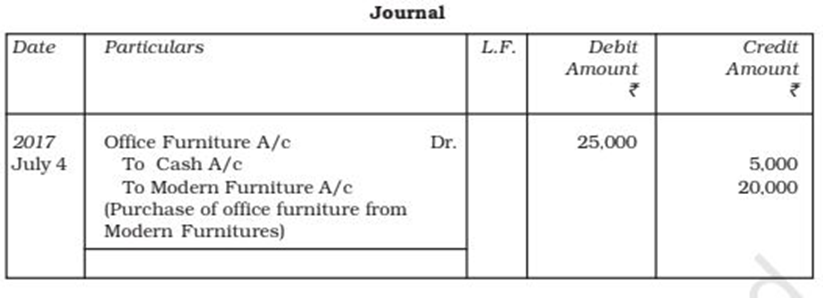
Books of Rohit Journal
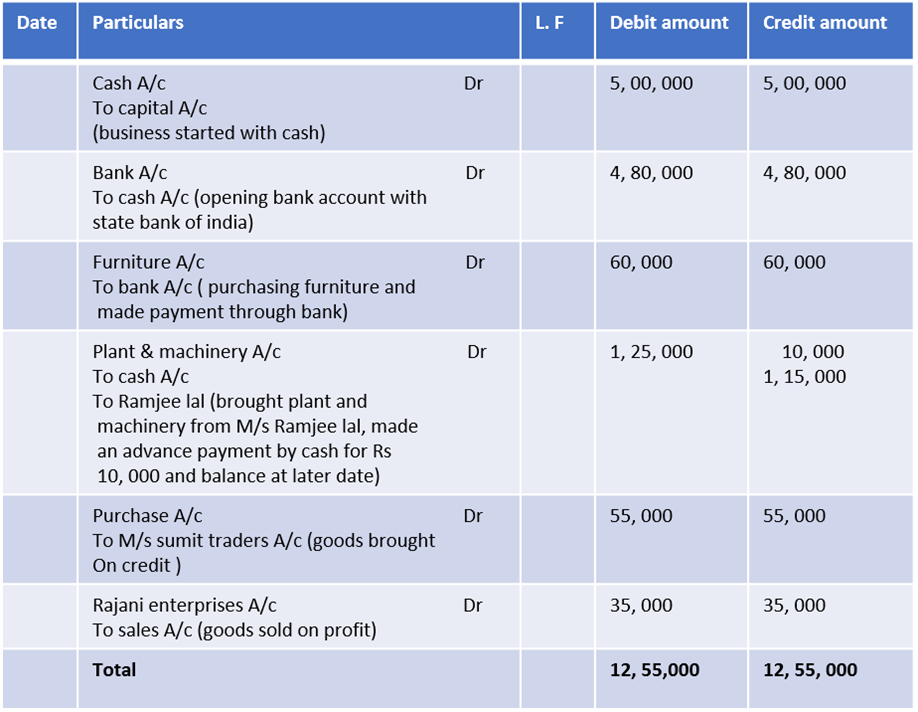
The Ledger
The ledger is the principal book of accounting system. It contains different accounts where transactions relating to that account are recorded. A ledger is the collection of all the accounts, debited or credited, in the journal proper and various special journal (about which you will learn in chapter 4). A ledger may be in the form of bound register, or cards, or separate sheets may be maintained in a loose leaf binder. In the ledger, each account is opened preferably on separate page or card.
A ledger is very useful and is of utmost importance in the organisation. The net result of all transactions in respect of a particular account on a given date can be ascertained only from the ledger. For example, the management on a particular date wants to know the amount due from a certain customer or the amount the firm has to pay to a particular supplier, such information can be found only in the ledger. Such information is very difficult to ascertain from the journal because the transactions are recorded in the chronological order and defies classification. For easy posting and location, accounts are opened in the ledger in some definite order. For example, they may be opened in the same order as they appear in the profit and loss account and in balance sheet. In the beginning, an index is also provided. For easy identification, in big organisations, each account is also allotted a code number.

According to this format the columns will contain the information as given below: An account is debited or credited according to the rules of debit and credit already explained in respect of each category of account. Title of the account : The Name of the item is written at the top of the format as the title of the account. The title of the account ends with suffix ‘Account’. Dr./Cr. : Dr. means Debit side of the account that is left side and Cr. Means Credit side of the account, i.e. right side. Date : Year, Month and Date of transactions are posted in chronological order in this column.
Particulars : Name of the item with reference to the original book of entry is written on debit/credit side of the account.
Journal Folio : It records the page number of the original book of entry on which relevant transaction is recorded. This column is filled up at the time of posting.
Amount : This column records the amount in numerical figure, corresponding to what has been entered in the amount column of the original book of entry.
Distinction between Journal and Ledger
The Journal and the Ledger are the most important books of the double entry mechanism of accounting and are indispensable for an accounting system.
Following points of comparison are worth noting :
1. The Journal is the book of first entry (original entry); the ledger is the book of second entry.
2. The Journal is the book for chronological record; the ledger is the book for analytical record.
3. The Journal, as a book of source entry, gets greater importance as legal evidence than the ledger.
4. Transaction is the basis of classification of data within the Journal; Account is the basis of classification of data within the ledger.
5. Process of recording in the Journal is called Journalising; the process of recording in the ledger is known as Posting.
Classification of Ledger Accounts
We have seen earlier that all ledger accounts are put into five categories namely, assets, liabilities, capital, revenues/gains and expense losses. All these accounts may further be put into two groups, i.e. permanent accounts and temporary accounts. All permanent accounts are balanced and carried forward to the next accounting period. The temporary accounts are closed at the end of the accounting period by transferring them to the trading and profit and loss account.
All permanent accounts appear in the balance sheet. Thus, all assets, liabilities and capital accounts are permanent accounts and all revenue and expense accounts are temporary accounts. This classification is also relevant for preparing the financial statements.
Posting from Journal
Posting is the process of transferring the entries from the books of original entry (journal) to the ledger. In other words, posting means grouping of all the transactions in respect to a particular account at one place for meaningful conclusion and to further the accounting process. Posting from the journal is done periodically, may be, weekly or fortnightly or monthly as per the requirements and convenience of the business.
The complete process of posting from journal to ledger has been discussed below:
Step 1 : Locate in the ledger, the account to be debited as entered in the journal.
Step 2 : Enter the date of transaction in the date column on the debit side.
Step 3: In the ‘Particulars’ column write the name of the account through which it has been debited in the journal. For example, furniture sold for cash ` 34,000. Now, in cash account on the debit side in the particulars column ‘Furniture’ will be entered signifying that cash is received from the sale of furniture. In Furniture account, in the ledger on the credit side is the particulars column, the word, cash will be recorded. The same procedure is followed in respect of all the entries recorded in the journal.
Step 4 : Enter the page number of the journal in the folio column and in the journal write the page number of the ledger on which a particular account appears.
Step 5 : Enter the relevant amount in the amount column on the debit side. It may be noted that the same procedure is followed for making the entry on the credit side of that account to be credited. An account is opened only once in the ledger and all entries relating to a particular account is posted on the debit or credit side, as the case may be.
We will now see how the transactions listed to different accounts from the journal.
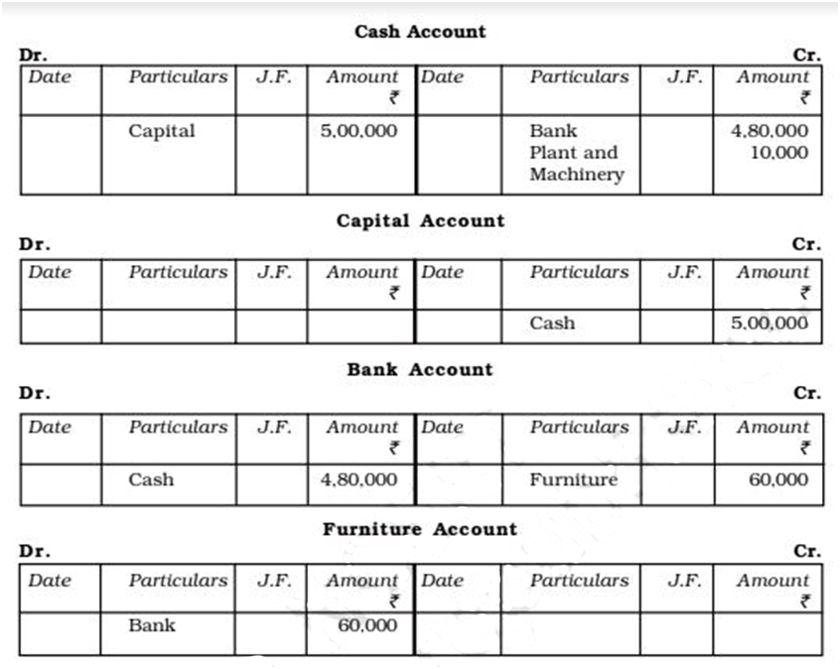
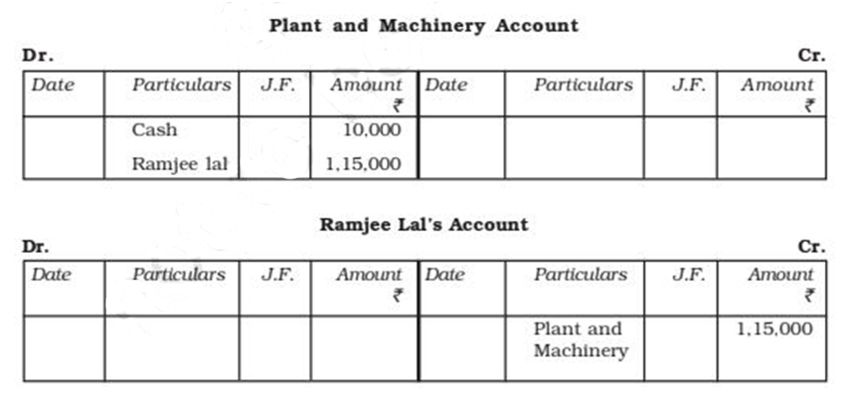
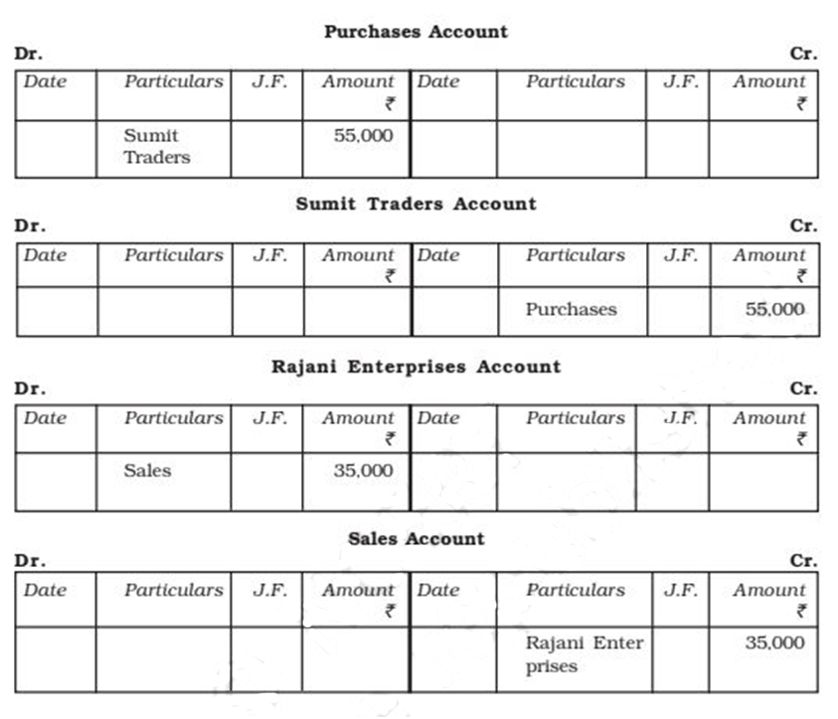

 SS MUKHI
SS MUKHI
